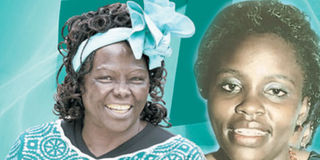Why cancer continues to stalk and kill mothers of the nation

The nation mourns two heroines, Wangari Maathai and Margaret Ogola, who fought and lost the battle against cancer. Photo/GRAPHICS
Of the things that rarely failed Prof Wangari Maathai one was her health.
On her 71st birthday last April, she narrated how only her children and former President Daniel arap Moi drove her to hospital.
“I never get ill and have only been to hospital when I was having my babies and when Moi beat me up,” she told the small crowd of Green Belt Movement staff who had organised a party for her after she returned from seeking treatment abroad.
The Nobel laureate had been diagnosed with ovarian cancer and her health started failing.
For decades nature had rewarded Prof Maathai for her good work in advocacy for the environment and civic rights by granting her good health.
But she was diagnosed with ovarian cancer and no expert could stop the march of the dreaded disease. She died on Sunday, September 25.
Prof Maathai became one of the rising statistics of cancer vicitms.
Even with the immense knowledge she possessed and the information and resources at her disposal, Prof Maathai, a hero to many people across the globe, fell to one of the most devastating diseases known to humankind.
And when the news of the Nobel laureate’s death broke, the nation was already grieving the passing of yet another heroine, Dr Margaret Ogola.
Dr Ogola was a paediatrician whose memories are more immortalised in the hearts and minds of a generation that studied her novel, The River and the Source, as part of schoolwork.
The critically acclaimed novel that was part of the high school literature set books for years was a description of the changing lives of four generations of Kenyan women through a certain period in history.
Of her book, Dr Ogola said: “The inspiration for this book came from my mother who handed down to me the wisdom and lives of her own mother and grandmother. This strength and support that is found in the African family is the most important part of our culture, and should be preserved and nurtured at all costs.”
Ms Harriet Koyoson, who worked closely with Dr Ogola at the Business School, said that the late medic used to describe herself in her characteristic wit as a writer who became a doctor.
Dr Ogola’s third novel, Place of Destiny, which won the author her second Jomo Kenyatta Prize for Literature in 2007, is about a woman dying of cancer and the rise to recognition of a former street child as well as issues of poverty.
It seems autobiographical because Dr Ogola battled with cancer for many years. She died at 53.
Hers, too, was a life of achievement and great promise brought to an end by the dreaded disease.
Although cancer statistics are a grey area – national data was last documented in 2004 – researchers rely on hospices and anecdotal data when gathering their facts, which currently point at 28,500 new cancer cases every year. Of these, 22,100 die.
“Such scenes are repeated in thousands of homes around the country. The majority of the deaths are the ones we do not know about,” said Mr Makumi, the first African to receive the ONS International Award for Contribution to Cancer Care.
Mr Makumi told Lifestyle that ovarian cancer is a leading cause of death for Kenyan women.
According to a research paper on ovarian cancer in Kenya published by the International Journal for Gynaecological Cancer, most women are diagnosed with an advanced stage of the disease.
The current North American standard of care includes surgery followed by carboplatin and paclitaxel. Neither drug is available to Kenyan women.
Dr Nafthali Busakhala of the Moi Teaching and Referral Hospital, who participated in the research, told Lifestyle that cancer among women in the country is increasing.
The most common form, said the researcher, is cervical and breast cancer.
“At Moi Teaching and Referral Hospital we are seeing about 20 new patients with cervical and 15 new patients with breast cancer every month. Five years ago, we saw about six new patients with both diseases every month. The major reason for this increase is a community breast and cervical cancer screening programme that we started three years ago,” he said.
The programme involves mobilisation, education and screening of communities around Eldoret town.
Dr Busakhala said the trend is that there are younger patients developing cancer but the average age is 50 years for both cancers.
“Another reason for the increase in patients with cervical cancer is infection by HIV and HPV. This is because both viruses cause cell changes in the body that result in cancer,” Dr Busakhala added.
Contrary to popular belief, factors like diet, the number of children, breast-feeding, use of family planning pills do not cause cancer but may increase the chances of developing cancer.
More than 60 per cent of those affected are under the age of 70. One has a 14 per cent chance of contracting a form of cancer before the age of 75.
World Health Organisation estimates that ever year 2,454 women are diagnosed with cervical cancer and 1,676 die.
Cervical cancer ranks as the second most frequent cancer among women in Kenya.
“Cancer is not a respector of persons. It is a disease that brings you to your knees and leaves you little or no chance of rising again. It is an expensive and wasting disease and no matter your background it leaves you bare,” said David Makumi, the vice-chairman of the Kenya Cancer Association.
Currently, cancer treatment costs vary depending on what form of the disease is present.
For instance, a breast cancer patient will spend more than a Sh1 million from diagnosis to treatment.
Medical check-ups and diagnosis alone may require Sh65,000 even before the treatment begins.
If doctors propose a mastectomy (the surgical removal of the infected breast), the patient will be required to part with almost Sh200,000 for the process.
For the subsequent chemotherapy treatment, a further Sh700,000 will be needed.
Those costs don’t include follow-up visits and radiotherapy if needed. The overall bill for a cancer patient could run into millions of shillings.
“Anyone would flinch at the figures involved,” said Mr Makumi. For a disease in which early detection is the line between life and death one would wonder why most cancers in patients are discovered in their late stages. Aren’t routine tests mandatory and necessary?
“We think a majority of our population know that routine medical tests are important. It is just that we never actually go for them until we are physically sick,” said Zipporah Ali of the Kenya Hospices Palliative Care Association.
Dr Ali argues that even among the middle class who have medical insurance, very rarely would someone walk into a hospital just for a test or a scan as a precautionary measure.
“And although at the end of the day we cannot fight death and win, medical marvels can delay its onset or stop it dead in its tracks, particularly where cancer is concerned,” she says.
There is another section of the population that has the relevant information, wants to undergo regular tests but can neither afford nor access the tests.
“By the time a test is available to them, it is often too late for any meaningful intervention such as chemotherapy, radiotherapy or amputation to be taken,” said Mr Makumi.
Been neglected
Treatment and research around cancer has been neglected by successive governments but things are looking up. Recently the government set aside more than Sh350 million for the establishment of cancer centres in all public hospitals.
According to the Minister for Medical Services, Prof Anyang’ Nyong’o, himself a survivor of prostate cancer, the money will be disbursed to public hospitals to enable them handle cancer cases.
This amount is, however, a drop in the vast ocean that is supposed to be cancer funding.
Prof Nyong’o admitted that Kenyatta National Hospital does not have the capacity to deal with cancer thus denying poor Kenyans the much needed medical care.
Even as we remember those who lost the fight, there is hope that 40 per cent of cancer cases can be prevented.
“Improve diets, increase physical activity and reduce tobacco and alcohol intake. It can be as simple as this,” said Dr Ali. “Plus, regular screening and getting as much information as possible on the disease.”
As a reaction to the increased cancer cases, the Ministry of Public Health recently announced plans to make cancer screening in government hospitals.
The two health ministries jointly set aside Sh150 million for the drive.
This kind of financial boost may be the light at the end of the tunnel that the country has been straining to catch a glimpse of.
“It is possible, even in very economically constrained environments, to be effective in preventing cancer and improving service to patients,” Public Health Minister Beth Mugo said at the launch of the Cancer Control Plan in August.
As planning continues in government boardrooms, health activists such Mr Makumi continue with the cause, humanitarians such as Dr Ali continue to stare at cancer in the face.
“There have been significant advances in research. We are all looking forward to the day a silver bullet will be found. But even before then, we can find our own kind of hope in the eyes of the survivors and in the spirits of those who have left before us,” says Dr Ali.




